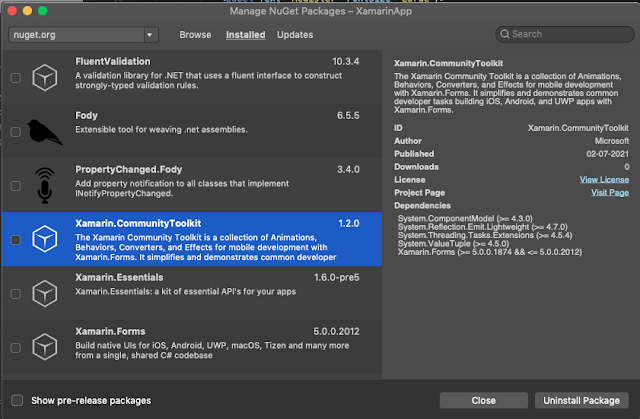In this blog, you will learn how to test Xamairn UI controls in
Xamarin.Forms.
Introduction
Xamarin.Forms code runs on multiple platforms - each of which has its own
filesystem. This means that reading and writing files is most easily done
using the native file APIs on each platform. Alternatively, embedded resources
are a simpler solution to distribute data files with an app.
Xamarin.UITest
Xamarin.UITest is a C# testing framework using NUnit for UI Acceptance Tests
on iOS and Android apps. It integrates tightly with Xamarin.iOS and
Xamarin.Android projects, Xamarin.UITest is the Automation Library that allows
the NUnit tests to execute on Android and iOS devices. The tests interact with
the user interface as a user would: entering text, tapping buttons, and
gestures - such as swipes.
Like Appium and Robot Framework, Xamarin.UITest is among the best open-source,
cross-platform UI testing frameworks. It’s a more straightforward choice when
it comes to automating Android and iOS apps built with Xamarin.Forms.
Follow the Arrange-Act-Assert pattern:
-
Arrange: The test will set up conditions and initialize things so
that the test can be actioned.
-
Act: The test will interact with the application, enter text, pushing
buttons, and so on.
-
Assert: The test examines the results of the actions run in the Act
step to determine correctness. For example, the application may verify that
a particular error message is displayed.
Prerequisites
- Visual Studio 2017 or later (Windows or Mac)
Setting up a Xamarin.Forms Project
Start by creating a new Xamarin.Forms project. You wíll learn more by
going through the steps yourself.
Create a new or existing Xamarin forms(.Net standard) Project. With
Android and iOS Platform.
Add UI Test Project
Now, Add the UI Test project to your existing Xamarin.forms project. Go to
your solution add a new project select Xamarin UI Project refer to the
following screenshot.
Name your UI Test project the click to add.
Use AutomationId
-
AutomationId should be added to all UI controls that are required for UI
testing.
-
AutomationId is a Dependency Property which can also be set with a binding
expression.
-
InvalidOperationException will be thrown if an attempt is made to set the
AutomationId property of an Element more than once.
-
AutomationId and X:Name are different. You must set AutomationId for all
controls.
Ex: AutomationId="EntryPhoneNumber"
Create a UI
Here, I'm going to create a simple UI for UI Testing.
MainPage.XAML
Configure App
Here, you need to configure both iOS and Android App paths see below code.
AppInitializer.cs
Android
You can specify your APK path. Go to your Android project debug/bin folder you
can find the com.companyname.xamarinapp.apk file you copy the file path and
set the ApkFile.
The device can be specified using the DeviceSerial method:
iOS
Specify the iOS IPA path. Go to your iOS debug/bin folder you can find the
AppName.iOS file you copy the file path and set the AppBundle.
iOS Enable Test Cloud
To run tests on iOS, the Xamarin Test Cloud Agent NuGet package must be added
to the project. Once it's been added, Add the following code into the
AppDelegate.FinishedLaunching method:
Xamarin Test Cloud Agent NuGet package
AppDelegate
Set Compiler Variable
Set compiler variable to your iOS app. Go to the project option in the
Compiler section set define symbols. "ENABLE_TEST_CLOUD" refer
below screenshot.
Write UI Test
Now, I'm going to write the Automation UI Test for PhoneNumber validation. See
below code
Run
The test method has been passed.
Download full source from Github
References
https://docs.microsoft.com/en-us/appcenter/test-cloud/frameworks/uitest/
I hope you have understood you will learn how to test Xamarin UI Elements
Xamarin.Forms.
Thanks for reading. Please share your comments and feedback.
Happy Coding :)























































